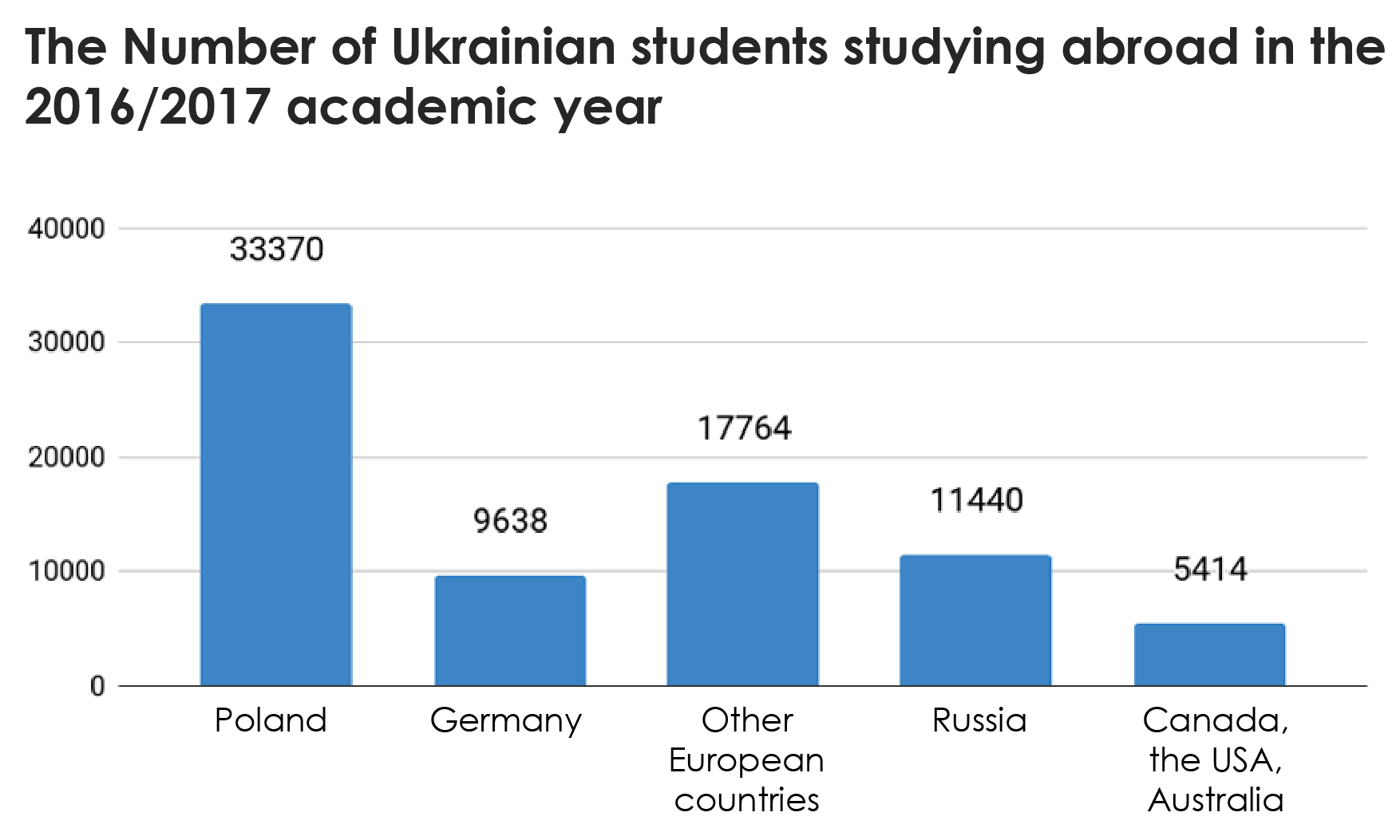We have completed our annual data collection on the number of Ukrainian citizens studying abroad and are ready to share the results.
First of all, we are going to talk about the change in methods of data collection from three countries: Russia, Romania and Belgium.
From this year on, we will include the data about Ukrainian citizens studying in Russian higher education institutions under state financing, which was significantly allocated by the Government of the Russian Federation to persons with Ukrainian citizenship after the aggression against Ukraine. The corresponding recalculation of the data was made not only for the last year but also for the previous ones. Previously, we didn't include state-financed students. We still don’t take into account data from Russia about Ukrainian citizens studying in occupied Crimea and Sevastopol, though.
Romania has changed the way foreign students are accounted for in their universities. They are defined not by citizenship but the country where they received secondary education. Earlier, we had a number of students with Ukrainian citizenship studying at Romanian universities. Now we have those who completed secondary schooling in Ukraine and study at Romanian universities.
Data from Belgium have been retrospectively updated and now presented separately for Flanders and Wallonia.
We will further explain why during the 2018/2019 academic year, we are providing data for the 2016/2017 academic year. It’s because the statistical data collection in different countries takes different amounts of time. In most countries, it takes about one year, whereas other countries provide access to the requested data after 1.5-2 years. Therefore, as of December 2018, the most recent available data is for 2017/2018 in most countries. However, there are some of them where the most recent available data is for 2016/2017. These countries include the United Kingdom, Belgium (Wallonia), Spain, Canada, Slovenia, France, Sweden. There are also countries, such as Greece, where access to data is restricted due to political or economic reasons. That is why the data collection takes longer. To compensate for this, we make a forecast for 2017/2018, which you can find below. Besides, in addition to this data, we provide the available data, including for 2017/2018.
Data for 2016/2017
Let's move on to the data itself. In the 2016/2017 academic year, 77,424 Ukrainian citizens studied at foreign universities. The Ukrainian HEIs (universities, academies and institutes of all forms of ownership) have about 900,000 Ukrainian full-time students. 8% of them made up those studying abroad. They tend to enroll in Poland, Russia, Germany, Canada, Czech Republic, Italy, the USA, Spain, Austria, France, Slovakia. These countries receive more than 90% of all Ukrainians studying abroad. In total, the number has more than tripled in the last nine years – from 24 104 to 77 424 students. Poland, Russia, Czech Republic, Slovakia, Austria, Italy, Spain, Canada and Bulgaria provided the largest increase.

|
The Number of Ukrainian students studying abroad in the 2016/2017 academic year |
|||
|
Poland |
33370 |
Belarus |
283 |
|
Russia |
11440 |
Latvia |
242 |
|
Germany |
9638 |
Estonia |
292 |
|
Canada |
3425 |
Belgium (Flanders) |
182 |
|
Czech Republic |
2471 |
Belgium (Wallonia)* |
36 |
|
Italy |
2536 |
Norway |
205 |
|
The USA |
1817 |
Finland |
175 |
|
Spain |
1762 |
Australia |
172 |
|
Austria |
1625 |
The Netherlands |
149 |
|
France* |
1348 |
Sweden |
131 |
|
Slovakia |
1169 |
Moldova |
117 |
|
Hungary |
838 |
Cyprus |
105 |
|
The UK |
770 |
Slovenia |
72 |
|
Bulgaria |
669 |
Azerbaijan |
32 |
|
Turkey |
506 |
Georgia |
40 |
|
Lithuania |
377 |
Ireland |
26 |
|
Romania |
327 |
Croatia |
44 |
|
Portugal |
369 |
Serbia |
20 |
|
Switzerland |
349 |
South Korea |
40 |
|
Greece* |
285 |
||
|
*The data for the 2015/2016 academic year |
|||
The forecast for 2017/2018
Given the data for 2017/2018 from 29 countries and assuming that the numbers won’t decrease in other countries, we predict that the final number of Ukrainian and foreign students in foreign universities in 2017/2018 will turn out to be at least 83,000 people. Providing that the Ukrainian HEIs (universities, academies and institutes of all forms of ownership) had about 890,000 Ukrainian citizens enrolled in full-time programs, about 8.5% of them studied abroad.
Who considers the Ukrainians strategically important?
We not only measure the number of Ukrainian students abroad but also what part they make up among other foreign students in each country. This way, we determine which country considers them strategically important and what foreign universities depend the most on the revenues Ukrainian students bring. For instance, many Ukrainians are studying at German universities, but they account for barely 3% of all foreign students. Therefore, if the number of Ukrainian students decreases, German universities will not suffer the change. They worry more about Turkish or Chinese students. After all, Germany has successfully diversified student inflows from different countries. That is why none of them account for more than 10% of the total number of foreign students.
Meanwhile, Ukrainian students are strategically important to Poland. They comprise 55% of all foreign students. Given that most of them pay out of pocket for both education and housing, they are important investments for Poland. Ukrainian students compensate for the demographic decline and the departure of the Polish youth to higher education institutions in other EU countries. Polish HEIs will continue to actively recruit in Ukraine to retain or even increase the number of students.
We can see a similar situation in Slovakia, where the Ukrainian students made up 30% in the 2018/2019 academic year. The only difference is that almost all of them study at the expense of the Slovak budget, which means that they bring budgetary funds to Slovak universities but often pay for their accommodation out of pocket just like the Slovaks. We assume that Slovak universities will also expand their recruitment in Ukraine.
The rapid increase in the number of Ukrainian students also makes them important for Bulgarian universities, especially for undergraduate programs, where students with a Ukrainian secondary school diploma make up almost 20% of those who have completed secondary education outside Bulgaria.
Russia doesn’t have any tangible benefits from the expenses of the Ukrainian students. However, they play a significant role in terms of politics for the Russian Federation. Russian pro-Kremlin media are always trying to exaggerate the number of Ukrainian citizens. They even distort their official state statistics. We observe another benefit in terms of politics Russia has dramatically increased state financing for Ukrainian students because after the attack on Ukraine. In 2014/2015, over 3,000 students were given state financing, although a little more than 300 people were recruited a year earlier. However, these quotas didn’t last long because, in 2017/2018, less than 500 Ukrainian citizens were recruited.
How to interpret this data?
Any generalized interpretation of the number of Ukrainian students in foreign universities is risky. We recommend refraining from this. Each country has its vision about the access of foreign students to higher education, their integration and other policies. That is why it’s impossible to use a one-size-fits-all approach.
Even the students have different motivations within a certain country. We offer to use a little simplified hypothesis: the more challenging it is to enroll in a foreign HEI, the higher is the competition, the greater the intellectual effort must be made – the easier it will be to understand the departure of a person to study abroad since the quality of higher education is higher. Currently, our special research of each of the above-listed countries shows that young people who have gone to study abroad are no longer satisfied with the living conditions in Ukraine. In particular, with the quality of higher education. They consider higher education in another country a bridge to a better future after graduation outside Ukraine.
However, not always our desires and intentions become reality. Not all Ukrainian students keep living abroad, even if it was their original plan.
Will improvements in the Ukrainian higher education system keep these people from going abroad? – Yes, but not directly. They will work indirectly and only provided other changes in the living standards in Ukraine.
Will the abolition of EIT or any other simplification in the entrance process to the Ukrainian universities keep these people from going abroad? – No. EIT is not the reason why Ukrainian students opt for foreign universities.
Will increased state financing in Ukrainian universities help to keep these people from going abroad? – No. First of all, the amount of available funds doesn’t need to be increased. The number of state-financed placed has to be decreased, otherwise, each of them will still be underfunded. That is why there are no conditions for an increase in state-financed places. Secondly, even if these conditions were met, competition for state-financed places in some specialties is either absent or low. Even now, it doesn’t hold back the outflow of young people, so the increase of state-financed places won’t work.
Will the outflow of these people abroad increase as a result of higher tuition fees in Ukrainian universities? – Yes, it will affect the outflow at some point. Especially, if the tuition fees increase will not be accompanied by the increase in the quality of higher education and better prospects for the Ukrainian students after graduation.
Data for the period 2008/2009 – 2017/2018.
The list of institutions that provided us with information
-
Australia – Australian Education International
-
Austria – Statistik Austria
-
Azerbaijan – Azərbaycan Respublikasının Dövlət Statistics Komitəsi
-
Belgium (Flanders) – Observatoire de l'enseignement supérieur Chargée de projet statistiques
-
Belgium (Wallonia) – AGERS, Agentschap voor Hoger Onderwijs, Volwassenenonderwijs en Studietoelagen Afdeling Hoger Onderwijs
-
Belarus – Ministry of Education of the Republic of Belarus
-
Bulgaria – National Statistical Institute
-
The United Kingdom – Higher Education Statistics Agency
-
Greece – Ελληνική Στατιστική Αρχή
-
Georgia – საქართველოს სტატისტიკის ეროვნული სამსახური
-
Estonia – Statistametamet
-
Ireland – Department of Education and Skills Statistics section
-
Spain – Servicio de Estadística Universitaria. Ministerio de Educación, Cultura y Deporte
-
Italy – Anagrafe Nazionale Studenti
-
Canada – Citizenship and Immigration Canada
-
Cyprus – Στατιστική Υπηρεσία της Κυπριακής Δημοκρατίας
-
Latvia – Centrālās statistikas parvaldes
-
Lithuania – Lietuvos statistikos departamentas
-
Moldova – Bureau of National Statistics
-
The Netherlands – Vereniging van Samenwerkende Nederlandse Universiteiten
-
Germany – Statistisches Bundesamt
-
Norway – Statistics Norway
-
Poland – Główny urząd statystyczny
-
Portugal – Direção-Geral de Estatísticas da Educação e Ciência
-
Russia – Ministry of Education and Science of the Russian Federation
-
Romania – Ministerul Educaţiei Naţionale
-
Serbia – Republic Statistics Factory
-
Slovakia – Centra vedecko-technických informácií SR
-
Slovenia – Statistical Office of the Republic of Slovenia
-
The USA – The Institute of International Education
-
Turkey – Yükseköğretim Kurulu
-
Hungary – Emberi Erőforrások Minisztériuma
-
Finland – Tilastokeskus
-
France – Ministère de l'Éducation nationale
-
Croatia – Central Bureau of Statistics
-
Czech Republic – Ministry of Education, Youth and Education
-
Switzerland – Bundesamt für Statistik BFS
-
Sweden – Statistiska centralbyrån
Support Cedos
During the war in Ukraine, we collect and analyse data on its impact on Ukrainian society, especially housing, education, social protection, and migration








